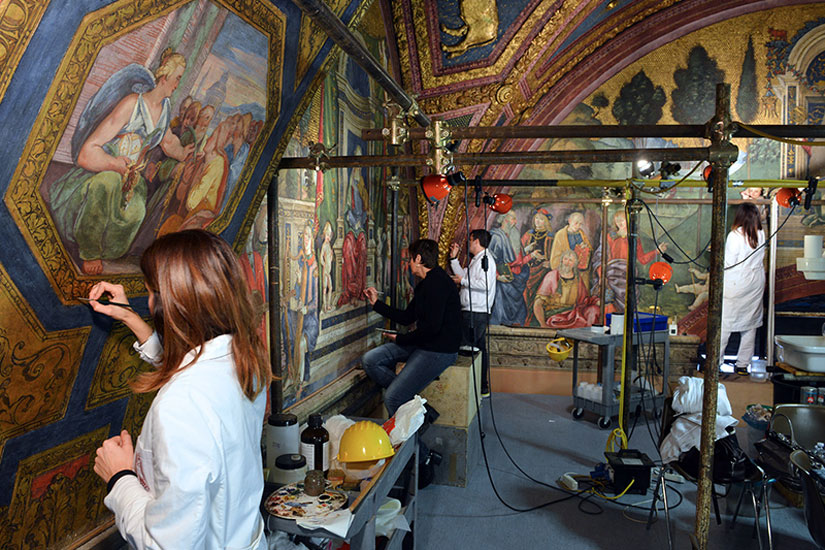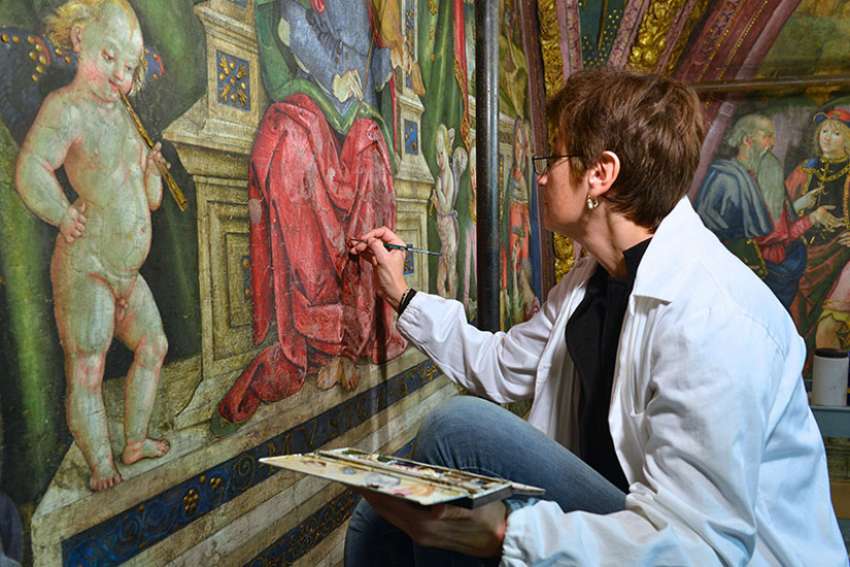The 15th-century master painted frescoes in numerous Italian churches, but his works on the apartments of the controversial Spanish pope, formerly known as Rodrigo Borgia, are now being restored to their former glory.
Alexander, who was elected in 1492, gave Bernardino di Betto, better known as “Pinturicchio,” two years to decorate his private apartments, where he greeted heads of state and partied with his mistresses at a time when popes were not always celibate.
Alexander is less known for his interest in arts and science than for his lusty affairs and blatant nepotism. But he was an intelligent man, trained as a lawyer, with an appreciation for the arts and sciences. He asked the artist to paint the walls of his luxurious apartments to reflect his intellectual interests.
King Charles VIII of France, a contemporary of Alexander’s, was reportedly disarmed by the rooms’ splendour when he made a visit.
Alexander’s daughter, Lucrezia, was apparently married in one of the rooms, and his ruthless son, Cesare, is rumoured to have killed a man in another.
When Alexander died in 1503, the rooms were sealed off by his successor Pope Pius III, effectively closing the door on one of the more controversial pontificates. The apartments remained closed for more than 400 years.
But Maria Ludmila Pustka, the Vatican’s chief restorer, said the pope, who fathered several children, is often misrepresented by modern media and film.
“Alexander was a very important, unique character for the political history of that time,” Pustka said. “He was an outsider, a Spaniard from Valencia and he brought a great openness to the Holy See. This pope really deserves more detailed analysis as he brought great innovation at a cultural and philosophical level.”
Pinturicchio and his apprentices set to work on the apartments just as an Italian named Christopher Columbus was exploring a continent on the other side of the Atlantic.
The restoration revealed Pinturicchio’s ‘The Resurrection,” one of the first European depictions of Native Americans in the New World.
Alexander asked Pinturicchio for paintings representing the origins of religion and his apartments are adorned with scenes from Egypt and ancient Rome.
 Art restorers at work in the Hall of the Liberal Arts in the Borgia Apartments in the Vatican Museums on Dec. 12, 2016. (RNS photo/courtesy of Chris Warde-Jones)
Art restorers at work in the Hall of the Liberal Arts in the Borgia Apartments in the Vatican Museums on Dec. 12, 2016. (RNS photo/courtesy of Chris Warde-Jones)
Pope Leo XIII reopened the apartments in 1889, but experts believe earlier restoration attempts may have caused more damage to the precious frescoes lining the walls and ceilings.
In 2001, after years of neglect, Pustka was charged with putting together a team of experts to restore four of the apartments’ richly decorated rooms.
“There are many rooms, around a dozen, altogether. But in reality there are four important rooms,” Pustka said.
With funds provided by the Vatican Museums’ American and Canadian patrons, the restorers began with the so-called Hall of the Mysteries of the Faith and are now putting the finishing touches on the Hall of the Liberal Arts.
“At first we had to evaluate the condition of the work and analyze the problems before we went anywhere near the art,” said Federica Cecchetti, a restorer who has been working on the apartments since 2005.
Wearing white coats and armed with delicate paintbrushes and palettes, experts recreated the finest details of scenes known as “lunettes” that line the walls portraying themes like astrology, music and geometry — all designed to represent man’s pursuit of knowledge and appreciation of culture.
Elaborate stucco featuring gilded bulls, the emblem of the Borgia family, adorns the ceilings while the walls are being brought back to life in vibrant shades of red, green and blue.
In the allegorical lunette devoted to music, musicians can be seen plucking the strings of instruments that were more common in the pope’s Spanish homeland.
“Pinturicchio wanted to transport us inside this world,” said Cecchetti, who has spent the past year restoring the “lunette” devoted to geometry. “Every day we are here in front of these works we discover something new, a particular detail.”
The rooms’ themes celebrate the House of Borgia, the pope’s family, and some of the paintings feature famous identities of the era, including family members and the famous Renaissance architect Donato Bramante.
Restorers found Pinturicchio left behind more than his masterpieces.
His fingerprints, and those of his assistants, were embedded in the candle wax they used for the buttons and medallions worn by the characters they painted on the frieze of the apartments.
Unlike other frescoes that were painted on wet plaster, Pintoricchio used a dry fresco technique that made his work less durable. Restorers worked to match the right colour and texture of paint with the original while ensuring they caused no further damage to the masterpieces.
“It takes a great deal of patience and the fear of making a mistake is always with you,” said Federica Runco, a restorer from Rome. “ As soon as you are 100 percent sure of yourself you can make an error that can be fatal.”
The restorers are expected to complete the restoration of the Hall of the Liberal Arts at the end of January, at which point it will open to the public.

